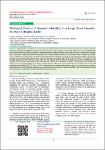Etiological Factors of Neonatal Mortality in a Large Rural Hospital- St. Mary’s Hospital Lacor
Abstract
Purpose: The aim of the study was to identify the gaps for further improvement of neonatal survival at St. Mary’s Hospital
Lacor, Gulu city Uganda. Objective: To determine the etiological factors associated with neonatal deaths in St. Mary’s Hospital Lacor
and examine neonatal mortality attributable to maternal conditions. Method: With the aid of a pre-coded and pretested data collection
tool, a consecutive sampling technique was applied to the neonates admitted searching for all records of dead neonates from October
2020 to September 2021 and used it to retrieve all medical records of neonates including: the total admissions, number of deaths or
recurrences of neonatal deaths, age at death, sex and diagnoses and analyzed using SPSS version 23 Result: The majority of all
neonatal deaths occur within the first 7days of life (82.7%) followed by those who are 8-28days old (17.3%). Amongst the dead
neonates, the male tended to predominate (60.6%) compared to their female counterparts (39.4%). Prematurity was the significantly
leading cause of neonatal mortality in St Mary’s Hospital (60.6%), followed by birth asphyxia (23.6%), neonatal sepsis (7.9%) and
congenital abnormalities (5.5%); P value = 0.0001. Maternal age and conditions like premature rupture of membrane, pre-eclampsia,
obstructed labor formed important contributors to neonatal outcomes Conclusion: Neonatal mortality could be significantly reduced
by focusing efforts on premature neonatal management and its prevention
Collections
- Research Articles [24]

